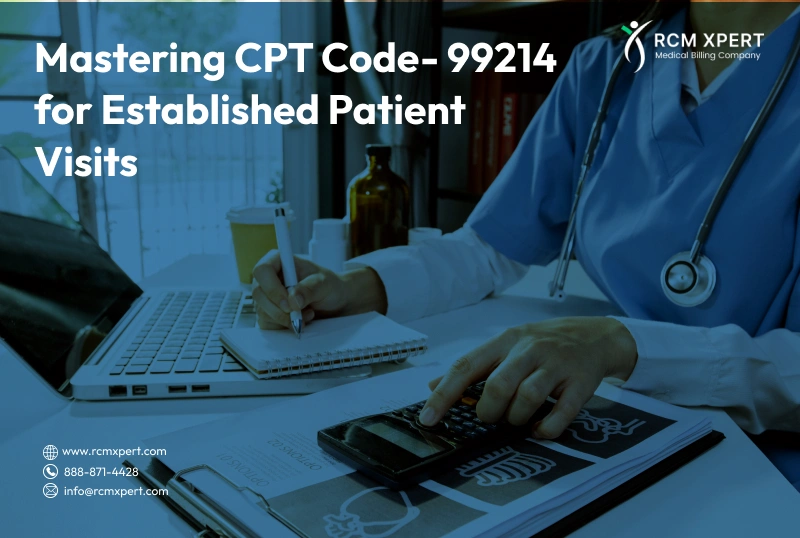The 99214 CPT code is the most essential component for medical providers’ billing for established patient office visits. Understanding and accurately using this code can have a considerable impact on the reimbursement process. Ensuring that medical billing professionals can use it efficiently to improve their practice’s efficiency and profitability.
Billing Criteria for CPT Code 99214
To bill for a 99214 CPT code, certain conditions must be completed that indicate the complexity and nature of the visit. This describes the major requirements that distinguish a 99214-level visit.
Medical Decision Making with Moderate Complexity
For a 99214 visit, the medical decision-making (MDM) process must be moderately advanced. This involves:
- There are multiple diagnoses and therapeutic options available, with a moderate risk of complications, morbidity, or fatality.
- Extensive data review.
Detailed History and Examination
The patient’s history and physical examination must be thorough, including:
- An extensive history of the current sickness
- A review of several systems.
- Relevant past, family-related, and/or social history.
- A thorough assessment of the afflicted body part(s) and associated systems.
Documentation Requirements
Accurate documentation is required to support the use of the 99214 CPT code. The records should reflect the complexity of the visit, including a comprehensive patient history, medical decision-making, and an examination that follows the recommendations specified.
Comparison of CPT Codes 99213 and 99214
Understanding the variations between codes 99213 and 99214 might help you bill correctly. Here is a comparative overview.
| Feature | CPT Code 99213 | CPT Code 99214 |
| Complexity | Low to moderate | Moderate |
| Time | Approximately 15 minutes | Approximately 25 minutes |
| MDM | Low to moderate complexity | Moderate complexity |
| History & Examination | Expanded problem-focused | Detailed |
Maximizing Reimbursement with CPT Code 99214: Three Pillars
Pillar 1: Detailed History – Capture Essential Information
When invoicing using the 99214 CPT code, it is necessary to record a complete history. This consists of a thorough evaluation of the patient’s medical, social, and family history, emphasizing the chronic and acute components of their disease. Make sure to document any relevant information, including signs and symptoms, previous treatments, and responses to those treatments. This comprehensive record supports the complexity required for a 99214 code and shows the medical necessity of the visit.
Pillar 2: Comprehensive Examination – Ensuring Accuracy in Documentation
A thorough examination is necessary to support the use of the 99214 CPT code. This examination should thoroughly examine the relevant systems, depending on the patient’s history. Every finding should be properly documented, providing a complete picture of the patient’s condition at the time of the visit. Accurate and complete documentation here not only validates the quality of treatment billed but also acts as a standard for future visits.
Pillar 3: Moderate-Complexity Medical Decision-Making
The third pillar, moderate-complexity medical decision-making, is combining the patient’s history and examination results with medical knowledge to effectively manage the patient’s condition. This includes examining various possible diagnoses or treatment alternatives, coping with the risk of serious complications, and utilizing advanced diagnostics. To meet the 99214 CPT code criteria, documentation must represent this complexity.
Effective Documentation
To achieve effective reimbursement, you must pay close attention to these pillars:
- Describe the history and examination thoroughly.
- Show modest difficulty in medical decision-making.
- Establish clinical documentation with billing code specifications.
Comparison of 3 Pillars
Here is a comparison of the three pillars necessary for maximizing reimbursement with CPT Code 99214, presented in a clear table format:
| Pillars for CPT Code 99214 | Key Components | Purpose in Billing |
| Pillar 1: Detailed History | Comprehensive review of medical, social, and family history<br> – Documentation of symptoms and treatments | Establishes the medical necessity and context for the visit |
| Pillar 2: Comprehensive Examination | Thorough assessment of relevant systems based on history<br> – Detailed recording of physical findings | Provides evidence for the complexity and thoroughness of the clinical assessment |
| Pillar 3: Moderate-Complexity Medical Decision-Making | Consideration of multiple diagnoses or treatments<br> – Management of potential complications<br> – Utilization of advanced diagnostics | Justifies the use of a higher-level billing code through complex decision-making processes |
Time and Complexity: Navigating the 99214 30-Minute Rule
When billing under the 99214 CPT code, it is essential to strike a balance between time and complexity. The 99214 CPT code often refers to office visits that last about 30 minutes. However, it is crucial to emphasize that time alone is not the only requirement for utilizing this code; the complexity of the medical decision-making process and the nature of the patient contact are also important. Documenting the visit’s complexity and detail assures billing compliance and helps to avoid potential audits.
Avoiding Downcoding: Optimizing Documentation for CPT 99214
Optimizing documentation is crucial for preventing downcoding and justifying the use of CPT 99214. Down coding happens when insurance carriers reduce billed services owing to a lack of documentation that supports the claimed level of treatment. To avoid this, make sure that the documentation clearly shows:
The scope of the history and examination: Clearly describe the patient’s history and examination.
- Medical decision-making is challenging.
- Describe in full the medical decision-making process, including patient information production, data analysis, and diagnostic and treatment plan justifications.
Documentation Tips for CPT 99214
To ensure billing accuracy with CPT code 99214 and optimize reimbursement, consider the following documenting practices:
- Detailed time spent: not only face-to-face time but also evaluating tests and history before the patient meeting.
- Clarify the complexity: Describe the nature of the issues addressed during the visit, the patient’s reaction to previous treatments, and any changes to the care plan.
Importance of Time and Complexity in Billing for CPT 99214
While the 30-minute length is a guideline for CPT 99214, the complex nature of the visit frequently determines whether this code is acceptable. The visit must include a thorough evaluation and moderate-complexity decision-making, frequently reflecting the time spent. The table below outlines the criteria for using CPT 99214 based on both time and complexity:
| Criteria | Description | Impact on Billing |
| Duration | Typically about 30 minutes of face-to-face time. | Sets a baseline expectation for the length of the visit. |
| Complexity of Services | It involves complex medical decision-making due to multiple diagnoses or treatment options. | Justifies using a higher billing code beyond the time spent alone. |
| Detailed History | A comprehensive review of the patient’s medical, family, and social history. | Supports the medical necessity of the visit duration. |
| Comprehensive Examination | Extensive examination of affected body systems based on the current complaint and history. | Indicates a thorough assessment correlating with time spent. |
| Documentation | Detailed notes that reflect the time spent, the complexity of care, and decision-making processes. | Crucial for audit-proof billing and justification of the CPT code. |
Key Points to Consider:
Documentation is crucial: Ensure that the notes appropriately reflect the complexity and duration of the visit. This is essential for compliance and auditing purposes.
- Assess appropriately: Always match the billing code with the level of treatment delivered. A visit that does not meet the moderate complexity threshold, even if it lasts 30 minutes, should not be paid under CPT 99214.
- Educate staff: All healthcare practitioners involved in patient care and documentation must understand these criteria’ significance to maintain consistent and accurate billing processes.
Building Audit-Proof Claims With CPT Code 99214 Documentation
Proper documentation is essential for successfully billing CPT code 99214. It enables compliance with healthcare standards and protects against audits by providing precise documentation of services given. Detailed, accurate documentation must show that the complexity and type of care delivered warrant the use of CPT code 99214.
Essential Documentation Tips for CPT Code 99214 Reimbursement
1. Describe the patient’s history and examination.
Ensure that the patient’s medical history and physical examination are fully documented. This comprises a detailed summary of the patient’s symptoms, medical history, and physical examination results. Each aspect should be equivalent to the complexity necessary for a 99214 code.
2. Specify the Complexity of Medical Decision-Making
Document all aspects of the medical decision-making procedure. This includes detailing the diagnoses, taking into account many potential concerns, and understanding the complexities of making a therapy selection. This section of the documentation must clearly show the moderate to high complexity of the service provided.
3. Time spent on the visit
While time alone does not warrant the use of CPT code 99214, recording the time spent on direct patient care is crucial, especially given the complexities of the decision-making process. Include both in-person and remote time spent evaluating testing, discussing the case with other healthcare experts, or documenting in the patient’s record.
4. Describe the Treatment and Follow-Up
Describe the treatment plan, medicines, and any suggestions for follow-up care. This indicates continuing patient management, which is an important part of moderate-complexity decision-making.
Effective Documentation
To create audit-proof claims for CPT code 99214, consider the following strategies:
| Documentation Aspect | Purpose | Impact on Billing |
| Detailed Patient History | Demonstrates the necessity for a detailed evaluation. | Supports the level of service billed. |
| Comprehensive Examination | Shows thorough assessment aligned with complex decision-making. | Justifies the use of a higher complexity code. |
| Clear Medical Decision-Making | Highlights the complexity and necessity of decisions made. | Essential for defending the use of CPT code 99214 in audits. |
| Documented Time | Correlates the amount of time spent with the service complexity. | Provides additional support for the level of service claimed. |
Confident CPT Code 99214 Billing: Bringing It All Together
Effective billing with the 99214 CPT code requires a thorough understanding and detailed documentation that correctly represents the complexities and time involved in patient care. As healthcare providers, skillfully understanding the complex rules of CPT code 99214 can lead to increased reimbursement and reduced audit risk. Here’s how to make sure your billing processes match these requirements.
Understanding The Requirements
A thorough understanding of the requirements is essential for invoicing for CPT code 99214 with confidence. This code is used for office visits with established patients and includes:
- Detailed patient history,
- Thorough examinations, and
- Moderately difficult medical decision-making.
Confident CPT Code 99214 Billing: Bringing It All Together
Effective billing with the 99214 CPT code requires a thorough understanding and detailed documentation that correctly represents the difficulties and time involved in patient care. As healthcare providers, skillfully understanding the complex rules of CPT code 99214 can lead to increased reimbursement and reduced audit risk. Here’s how to make sure your billing processes match these requirements.
Understanding The Requirements
A thorough understanding of the requirements is essential for invoicing for CPT code 99214 with confidence. This code is used for office visits with established patients and includes:
Confident CPT Code 99214 Billing: Bringing It All Together
Effective billing with the 99214 CPT code requires a thorough understanding and detailed documentation that correctly represents the difficulties and time involved in patient care. As healthcare providers, skillfully understanding the complex rules of CPT code 99214 can lead to increased reimbursement and reduced audit risk. Here’s how to make sure your billing processes match these requirements.
Understanding The Requirements
A thorough understanding of the requirements is essential for invoicing for CPT code 99214 with confidence. This code is used for office visits with established patients and includes:
Detailed patient history, thorough examinations, and moderately difficult medical decision-making.
Streamlining the Process
To streamline your billing process and ensure accuracy:
- Checklist for Documentation: Use a standardized checklist that covers all aspects of 99214 requirements to prevent any omissions.
- Training: Regular training sessions for medical staff on the latest coding updates and documentation practices can help maintain high standards.
- Audit Regularly: Conduct internal audits to ensure compliance and address any discrepancies before they become issues with insurers.
Simplified Comparison Table
To illustrate how CPT code 99214 stacks up against lower complexity visits, here’s a simplified comparison:
| Feature | CPT 99213 (Lower Complexity) | CPT 99214 (Moderate Complexity) |
| Time | 15 minutes | 30 minutes |
| History | Problem-focused | Detailed |
| Examination | Limited | Comprehensive |
| Decision Making | Low complexity | Moderate complexity |
Final Thoughts
Billing with CPT code 99214 does not have to be complicated. Healthcare providers can submit compliant and reimbursement-optimized claims with a clear awareness of the standards, careful documentation, and regular training. This not only ensures the practice’s economic viability but also demonstrates a dedication to comprehensive, patient-centered treatment. By using these practices, your billing process for CPT code 99214 becomes stronger, resulting in fewer denials and improved compliance with healthcare standards.














